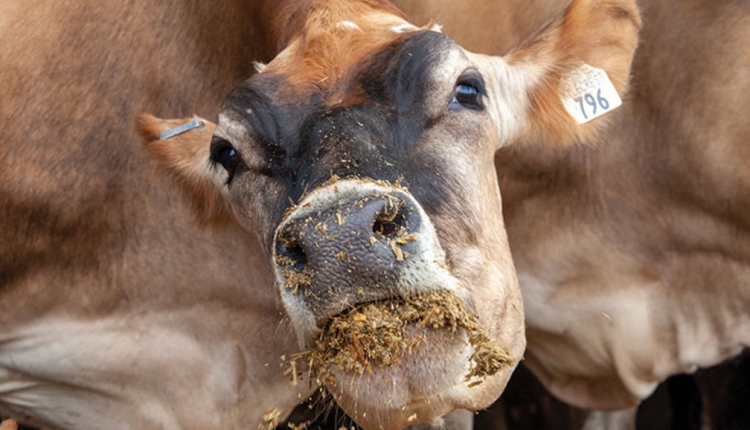Carbs are foundational to forage quality |
| By John Goeser |
|
|
|
The author is the director of nutrition research and innovation with Rock River Lab Inc, and adjunct assistant professor, University of Wisconsin-Madison’s Dairy Science Department.  Beef and dairy cattle derive energy from forage fiber, starch, and sugars. In the August/September “Feed Analysis” column, we delved into forage protein and its associated complex feed analysis measures. The nitrogen and amino acids in forage are valuable, with protein supplement costs near record highs. However, a majority of your forage quality is better defined by a different feed fraction, namely carbohydrates. At least 50% of the forage energy is derived from carbohydrates, so estimating quality based on carbohydrates is reasonable. The carbohydrate nutrient class is the second we’ll cover in our dedicated column series discussing feed analysis interpretation. Forage fiber, starch, and sugar levels prove pivotal in defining forage quality because these nutrients relate to both energy and feed intake. From an energy perspective, these three different carbohydrates each contain approximately 4 calories per gram in potential energy. Yet, forage fiber contributes only half the digestible energy value per gram relative to starch and sugar due to limited fiber digestion in dairy and beef cattle. Here, we’ll focus our attention on improving your understanding of the different carbohydrate fractions reported on the feed analysis. A detergent rinse Fiber relates to both energy and feed intake. Cornell University’s Peter Van Soest developed a detergent system for fiber analysis in ruminant nutrition. His research laid the foundation for our commercial feed analysis, where forage testing laboratories use different detergents to rinse away nonfiber feed fractions and then measure the insoluble remaining fraction. Through Van Soest’s work, the neutral detergent fiber and acid detergent fiber measures were born and are reported on your forage analysis as aNDF and ADF. In reality, the aNDF and ADF describe neutral and acid detergent insoluble fiber, respectively. The aNDF and ADF laboratory measures are like a laundry machine cycle. The laundry detergent washes away the dirt and grime, and you’re left with clean clothing. At the forage lab, technicians use detergents to wash away starch, sugar, protein, and other nonfiber compounds, and then fiber is left. Lignin is also measured in a similar fashion to ADF and aNDF, but with a concentrated sulfuric acid. Lignin values reflect a completely indigestible component in fiber and forage. The “a” in the aNDF acronym describes amylase, which is important alongside the neutral detergent to extract starch in starch-rich feeds such as corn silage. There is also a bit of soil and ash that’s retained in the fiber measures; aNDFom accounts for this by subtracting the ash that’s in the insoluble NDF. Think of this like sand in your pants pockets after the laundry rinse. The ADF and aNDF measures have become the bedrock for forage quality measures such as relative feed value (RFV). For more discussion around RFV and other hay evaluation index measures, reference the three articles from 2020 that Dave Mertens and I wrote in Hay & Forage Grower. Generally speaking, aNDF is a focal point on the forage analysis, with higher quality dairy forage being 40% to 45% aNDF or less. In forages, less fiber means more energy because the calories in fiber are partly locked in lignin and are less digestible relative to starch, sugar, and other feed components. Hence, more fiber dilutes the other energy-rich components in fiber. Additional carbs Mary Beth Hall, a dairy scientist with the U.S. Dairy Forage Research Center in Madison, Wis., standardized the starch analysis over the past decade. Starch is a chain of glucose molecules, and laboratories measure starch by breaking it down into glucose. Then the technicians measure the resulting glucose with a hospital grade glucose analyzer. Following Hall’s work, starch content in forage and grains is now one of the most accurate measures on your report. While starch is reliable and quantifies a known compound, crude sugar measures are a bit different. Sugar is like crude protein, with crude sugar measured using either ethanol or water as solvents to extract sugar-like compounds. The water-soluble carbohydrate (WSC) or ethanol-soluble carbohydrate (ESC) measures represent an estimate of true plant sugar. Water extracts more sugar-like compounds than ethanol, which is why WSC is typically greater than ESC. In the future, measuring known forage sugars such as fructose, sucrose, and glucose will replace the WSC and ESC measures on your forage analysis. For current dairy and beef nutrition purposes, focus your attention on the WSC measure to assess sugar levels. Hay and baleage will contain more sugar than silage due to sugar being used by fermenting bacteria in the ensiling process. Typical WSC measures in forage range from near zero to 10% or more. Bringing this article full circle, remember that carbohydrates define forage quality. With an improved understanding of the fiber, starch, and sugar measures on your forage analysis report, rank your forages based upon these carbohydrate measures, with lower fiber and more starch or sugar being the goal. Fiber and starch digestibility are also important for ranking forages, and interpreting this aspect of your forage analysis report will be covered in a future column. This article appeared in the November 2022 issue of Hay & Forage Grower on page 30. Not a subscriber? Click to get the print magazine. |
